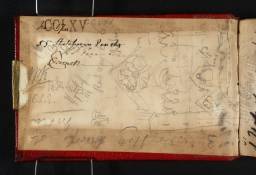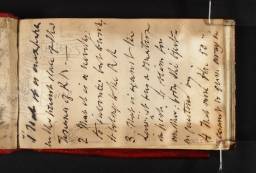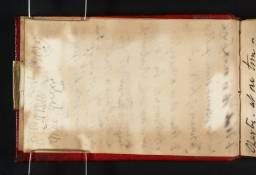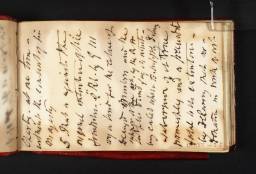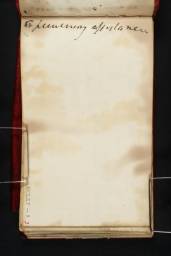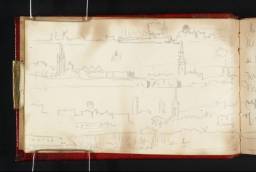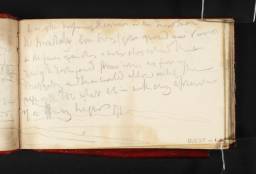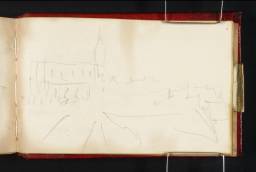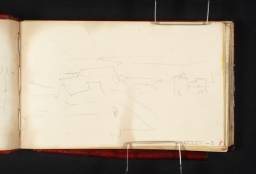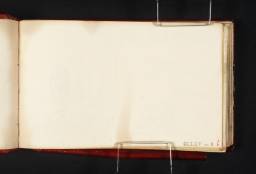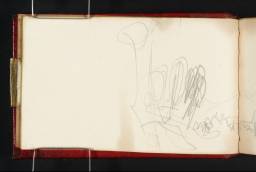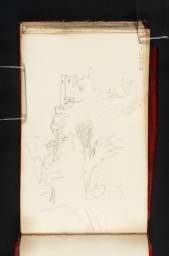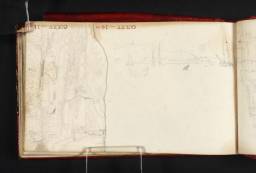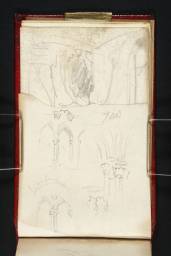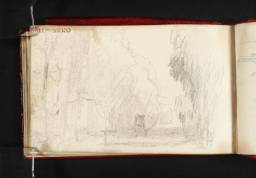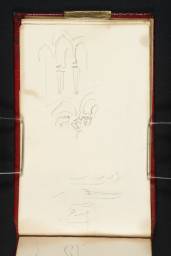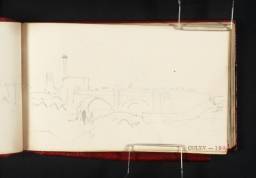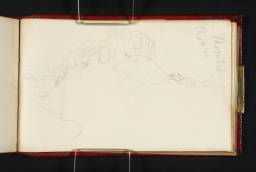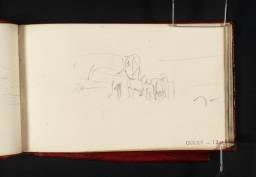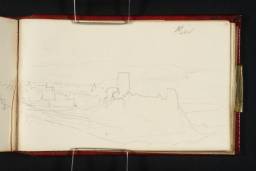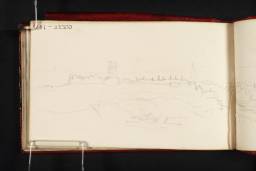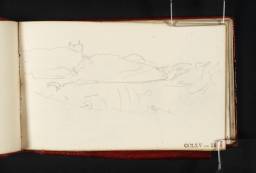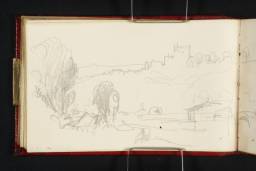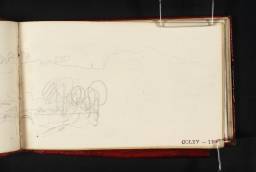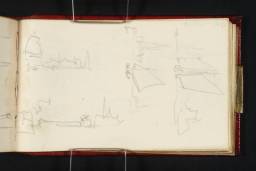Turner Bequest CCLXV
Red leather bound pocket book with a pencil holder and one brass clasp.
65 sheet of white wove writing paper watermarked ‘C Wilmot | 1830’ made by Charles Wilmott at Shoreham Mill in Kent.
Approximate paper size 59 x 96 mm.
Front cover blindstamped with the Turner Bequest stamp at the top left.
Numbered ‘217’ as part of the Turner Schedule 1854, and endorsed by the Executors of the Turner Bequest on the inside front cover (D41232).
65 sheet of white wove writing paper watermarked ‘C Wilmot | 1830’ made by Charles Wilmott at Shoreham Mill in Kent.
Approximate paper size 59 x 96 mm.
Front cover blindstamped with the Turner Bequest stamp at the top left.
Numbered ‘217’ as part of the Turner Schedule 1854, and endorsed by the Executors of the Turner Bequest on the inside front cover (D41232).
Accepted by the nation as part of the Turner Bequest 1856
Exhibition history
References
John Ruskin summed up his opinion of this sketchbook with a single word on the wrapper, ‘valueless’.1 A quick flick through the sketchbook would have revealed that almost all of the pages contained rapidly executed sketches, some having taken no more than a few seconds to execute, and none that formed the basis of finished designs, although some contributed to details or designs of watercolours. However, as a small breast pocket-sized notebook it was easily at hand whenever Turner needed a scrap of paper, and thus contains a variety of material, including notes and sketches about subjects not covered elsewhere. The fact that the sketchbook was in and out of Turner’s pocket is evinced by the mixed-up order of sketched subjects, a symptom of the artist often opening the book at random to find space for a drawing.
The sketchbook was used principally during Turner’s tour of Scotland in 1831, which he made to collect material to illustrate Sir Walter Scott’s Poetical Works (see Tour of Scotland for Scott’s Poetical Works 1831 Tour Introduction). However, it seems to have been first used in 1830 for notes relating to Royal Academy business (folios 1; D25644). Some of the other unidentified sketches in this book may have also been made in 1830 before the Scottish tour.
The use of this sketchbook during the Scottish tour was somewhat ad hoc; the small notebook (having the advantage of being pocketable) could be taken out at a moment’s notice, or forgotten about for a time. It was probably first taken out at Liverpool (folio 3 verso; D25648) or Manchester (folio 34; D25702) around 22 July 1831.2 At least some of the sketches of shipping in the present book may also have been made on the Mersey (folio 10; D25659).
The book then went back into Turner’s pocket for about two weeks while he used the Rokeby and Appleby sketchbook (Tate D25524–D25643; D41065–D41067 complete; Turner Bequest CCLXIV) and the Minstrelsy of the Scottish Border sketchbook (Tate D25762–D25928; D41077–D41078 complete; Turner Bequest CCLXVI). He took up the Berwick sketchbook once more on 5–11 August, when he began touring the border country around Sir Walter Scott’s home of Abbotsford, and went on his journey to Berwick-upon-Tweed with Robert Cadell.3 This section of the tour is recorded more fully in the Abbotsford sketchbook (Tate D25929–D26095; D40995–D40996 complete; Turner Bequest CCLXVII). Turner may have made one sketch at Abbotsford in this book (folio 63; D25756), as well as sketches of Newark Castle (folio 16; D25668), the Ettrick Water near Selkirk (folio 30a–31; D25696–D25697), Jedburgh (inside front cover; D41232) and Roxburgh (folio 12 verso; D41233).
The most significant sketches in the book were made at Berwick-upon-Tweed on 10 and 11 August (folios 13 verso; D25665). A few sketches record Turner’s journey from Berwick to Edinburgh from 11 to 13 August, with views of Fast, Innerwick, and Hailes Castles (respectively folios 47, 8 and 23 verso; D25728, D25655, D256683). Turner may also have made a few sketches round Leith (folio 21; D25678). The book was used for the last time on this tour around Edinburgh during a day trip on 15 August to Blackford Hill, Duddingstone Loch and Craigmillar Castle (respectively folios 63 verso, 7 and 42 verso; D25757, D25654, D25719).
Of particular interest among the sketches that were probably not made during the tour are two studies for vignettes (folio 29 verso, 30; D25694, D25695) made in preparation for Rogers’s Poetry. There are also a number of sketches throughout the book of figures in costume (see folio 57; D25745) that have no particular link to the tour. Finally there is a note recording a remedy for cholera which Robert Cadell probably sent to Turner in a letter (folio 42; D25718).
The style of the majority of these sketches are suited to the nature of the small notebook: quick, slight and perfunctory, and it is partly due to this fact that some of the sketches remain unidentified. These drawings may not be considered as significant studies for subsequent works (although some such as the Berwick sketches and the vignette studies did contribute in a small way to later designs), but they contribute to our knowledge of Turner’s travels in 1831. They also offer a flavour of Turner’s travels, reminding us that even while he was on the move, he was scanning his surroundings for subjects worthy of being committed to paper.
Gerald Finley notes that Turner wrote to Robert Cadell from Manchester on 22 July 1831. Finley 1980, p.91.
Technical notes
How to cite
Thomas Ardill, ‘Berwick sketchbook 1831’, sketchbook, May 2010, in David Blayney Brown (ed.), J.M.W. Turner: Sketchbooks, Drawings and Watercolours, Tate Research Publication, December 2012, https://www

